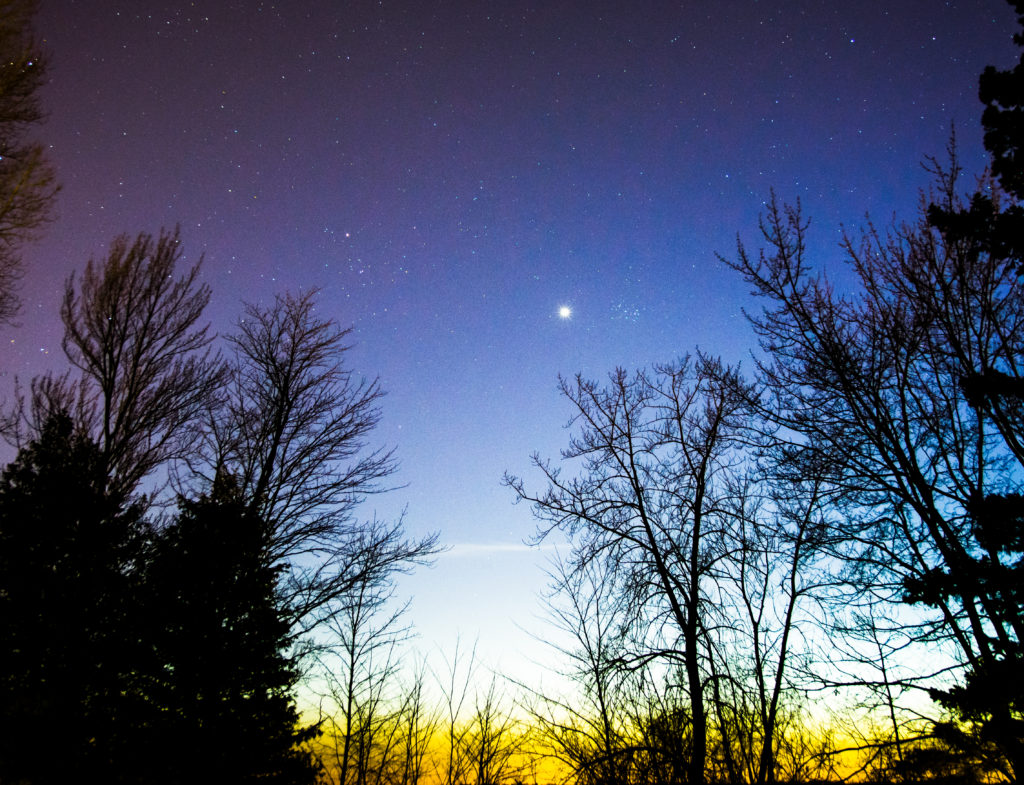The Night Sky This Month – April 2018

Another month, another fine collection of sights to see in the night sky. The brilliant constellations Taurus, Orion, and Canis Major turn to the west after sunset and are nearly gone for the year. Early risers can see three bright planets in pre-dawn sky. The Moon and the planet Venus get themselves tangled amidst two prominent star clusters in later April. And a respectable meteor shower puts on a show, with some hope of surprising to the upside this year. Here’s what to see in the night sky this month…
PUBLISHER’S NOTE: It’s open for just one week this year, but my annual Fundamentals of Stargazing course is now available for registration. This course is perfect for beginners or for more experienced stargazers who’ve been away from the night sky for a while and need a refresher. It’s the course I wish was available when I took up astronomy again, after a long break, more than a decade ago. Learn more at this link: https://cosmicpursuits.com/stargazing/

2-3 April. Mars and Saturn are separated by less than 2 degrees, about the width of your thumb held at arm’s length. This month, Mars is slightly brighter and much redder than pale yellow Saturn. Mars will get brighter still and rival Jupiter by the end of July.
3-8 April. Watch the waning Moon march eastward each night and pass three bright planets. The Moon moves through Libra and past Jupiter on the 3rd and 4th. Jupiter rises at about 11 p.m as April gets underway, and it shines brightly in the southern sky (or nearly overhead in the southern hemisphere) by about 3 a.m. By late in the first week of April, the Moon moves through Scorpius and into Sagittarius where Mars and Saturn rise in the east or southeast in the early morning hours. Jupiter, Saturn, and Mars will put on a splendid show in the coming months as they pass through opposition, one after the other, in May, June, and July, respectively.
8 April. Last Quarter Moon, 7:18 UTC
16 April. New Moon, 1:57 UTC
18 April. Saturn rises a little earlier each night as April progresses. It emerges above the southeastern horizon at 2:30 a.m. at the beginning of the month and at 12:45 a.m. by the end. And today, the planet reaches aphelion, its furthest position from the Sun in its orbit and its furthest aphelion since 1959.
18 April. Look to the west, just after sunset, to spot a very slender crescent Moon. As darkness begins to fall, look also for the stars of the Hyades sprinkled around the Moon. The bright star Aldebaran is just a couple of degrees away. Binoculars will help you see this lovely arrangement.
22 April. First Quarter Moon, 21:46 UTC
22 April. The Lyrid meteor shower peaks tonight. Look for meteors that trace their apparent paths back to a point between the constellations Hercules and Lyra, both of which rise in the east around midnight. You can see these meteors at any time of night, from nearly anywhere on Earth, but you may have more luck after midnight as the Earth turns into the meteor stream and the first quarter Moon sets. The shower typically produces 15-20 meteors per hour, but some years have yielded surprise outbursts of several hundred per hour. The Lyrids, which have been observed for at least 2,500 years, originate as the Earth passes through a stream of debris left by Comet C/1861 G1 (Thatcher).

24 April. Look for brilliant Venus just two finger widths southeast of the Pleiades star cluster tonight. They appear in the western sky after sunset. Binoculars will help. In a telescope, the planet appears nearly fully lit. Venus shines at magnitude -3.9, brighter than anything else in the sky except for the Moon and Sun.
29 April. Mercury, which was at inferior conjunction with the Sun at the beginning of the month, has speedily reached its greatest western elongation at 27º from the Sun. It appears in the morning sky before sunrise. From the northern hemisphere, the planet is just 10º above the horizon for this apparition. Observers in the southern hemisphere will enjoy a better view as the planet rises nearly 20º above the horizon well before sunrise.
30 April. Full Moon, 00:58 UTC
30 April. Look for the full Moon in Libra, near the bright planet Jupiter. The planet rises just half an hour after sunset as April comes to an end. It shines at a brilliant magnitude -2.5 and is now spectacular in a small telescope as it moves towards its closest approach to Earth on May 8. The planet is nearly 44” across.